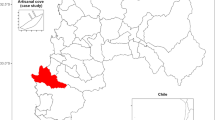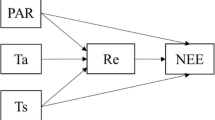Abstract
Law of the Sea negotiations and The Fishery Conservation and Management Act of 1976 create new options in fisheries management. Historical analysis of two major management programs in the United States of America, Columbia River chinook salmon (Oncorhynchus tshawytscha) and Pacific halibut (Hippoglossus stenolepis), shows two unresolved management problems. One is the innovativeness of fishermen in seeking ways to improve their harvests. The other is changing social priorities that are largely unpredictable and outside the control of fisheries managers. A method for analysis of patterning associated with management goals is illustrated. Since the general management goals are harvest improvement and more predictability, measures are used which show the adequacy of fit and reduction in variability between actual and predicted management outcomes.
Similar content being viewed by others
Literature cited
Bell, F.H. 1970. Management of Pacific Halibut. p. 209–222. In N.G. Benson, ed., A Century of Fisheries in North America. American Fisheries Society, Washington, D.C.
Bell, F.H., H.A. Dunlop, and N.L. Freeman. 1952. Pacific Coast Halibut Landings 1888 to 1950 and Catch According to Area of Origin. International Fisheries Commision Report No. 17, Seattle. 47p.
Bell, F.H. and G. St.-Pierre. 1970. The Pacific Halibut. International Pacific Halibut Commission Technical Report No. 6, Seattle. 108 p.
Bullard, O. 1968. Crisis on the Columbia. Touchstone, Portland. 151 p.
Campbell, B.A. 1972. Limited Entry in the Salmon Fishery: The British Columbia Experience. Centre for Continuing Education, University of British Columbia. PASGAP 6, 13 p.
Chapman, D.C, R.J. Myhre, and G. Morris. 1962. Utilization of Pacific Halibut Stocks: Estimation of Maximum Sustainable Yield, 1960. International Pacific Halibut Commission Report No. 31, Seattle. 35 p.
Cooley, R.A. 1963. Politics and Conservation: The Decline of the Alaska Salmon. Harper and Row, New York. 230 p.
Crutchfield, J. and A. Zellner. 1962. The Economic Aspects of the Pacific Halibut Fishery. Fishery Industrial Research 1(1):1–173.
Crutchfield, J. And A. Zellner. 1962. The Economic Aspects of the Pacific Halibut Fishery. Fishery Industrial Research 1(1):1–1973.
Fish Commission of Oregon and Washington Department of Fisheries. 1975. Status Report Columbia River Fish Runs and Commercial Fisheries, 1938–73, 1974 Addendum. Mimeographed, Portland and Olympia. 44 p.
Hatley, T.A. 1976. Efficiency on Oregon's Commercial Salmon Fisheries: A Historical Perspective. M.A. Thesis, Oregon State University, Corvallis. 142 p.
Hoag, S.H. and R.R. French. 1976. The Incidental Catch of Halibut by Foreign Trawlers. International Pacific Halibut Commission Scientific Report No. 60. Seattle. 24 p.
International Pacific Halibut Commission. 1975. Annual Report, 1974. Seattle. 32 p.
International Pacific Halibut Commission. 1963. Regulation and Investigation of the Pacific Halibut Fishery in 1962. Report No. 33. Seattle. 27 p.
Mundt, J.S. 1974. Limited Entry Into the Commercial Fisheries. Institute for Marine Studies, University of Washington, Seattle. 143 p.
Netboy, A. 1958. Salmon of the Pacific Northwest: Fish vs. Dams. Binfords and Mort, Portland. 122 p.
Netboy, A. 1974. The Salmon, Their Fight for Survival. Houghton Mifflin, Boston. p. 263–310.
Nie, N.H., C.H. Hull, J.G. Jenkins, K. Steinbrenner, and D.H. Bent. 1975. Statistical Package for the Social Sciences. Second Edition, McGraw-Hill Book Company, New York. 675 p.
Pacific Northwest River Basins Commission. 1972. Status of Columbia River Salmon and Steelhead Trout. Mimeographed, Vancouver. 50 p.
Pacific Northwest Regional Commission. 1976. Columbia Basin Salmon and Steelhead Analysis. 74 p.
Richards, J.A. 1968. An Economic Evaluation of Columbia River Anadromous Fish Programs. Ph.D. dissertation, Oregon State University, Corvallis. 286 p.
Skud, B.E. 1972. A Reassessment of Effort in the Halibut Fishery. International Pacific Halibut Commission Scientific Report No. 54, Seattle. 11 p.
Skud, B.E. 1976. Jurisdictional and Administrative Limitations Affecting Management of the Halibut Fishery. International Pacific Halibut Commission Scientific Report No. 59. Seattle. 24 p.
Smith, C.L. 1974. Oregon Fish Fights. Oregon State University Sea Grant Publication No. ORESU-T-74-004. Corvallis. 15 p.
Thompson, W.F. 1950. The Effect of Fishing on Stocks of Halibut in the Pacific. University of Washington Press, Seattle. 60 p.
van Hyning, J.M. 1968. Factors Affecting the Abundance of Fall Chinook Salmon in the Columbia River. Ph.D. dissertation, Oregon State University, Corvallis. 438 p.
Author information
Authors and Affiliations
Rights and permissions
About this article
Cite this article
Smith, C.L. The failure of success in fisheries management. Environmental Management 1, 239–247 (1977). https://doi.org/10.1007/BF01867288
Issue Date:
DOI: https://doi.org/10.1007/BF01867288




